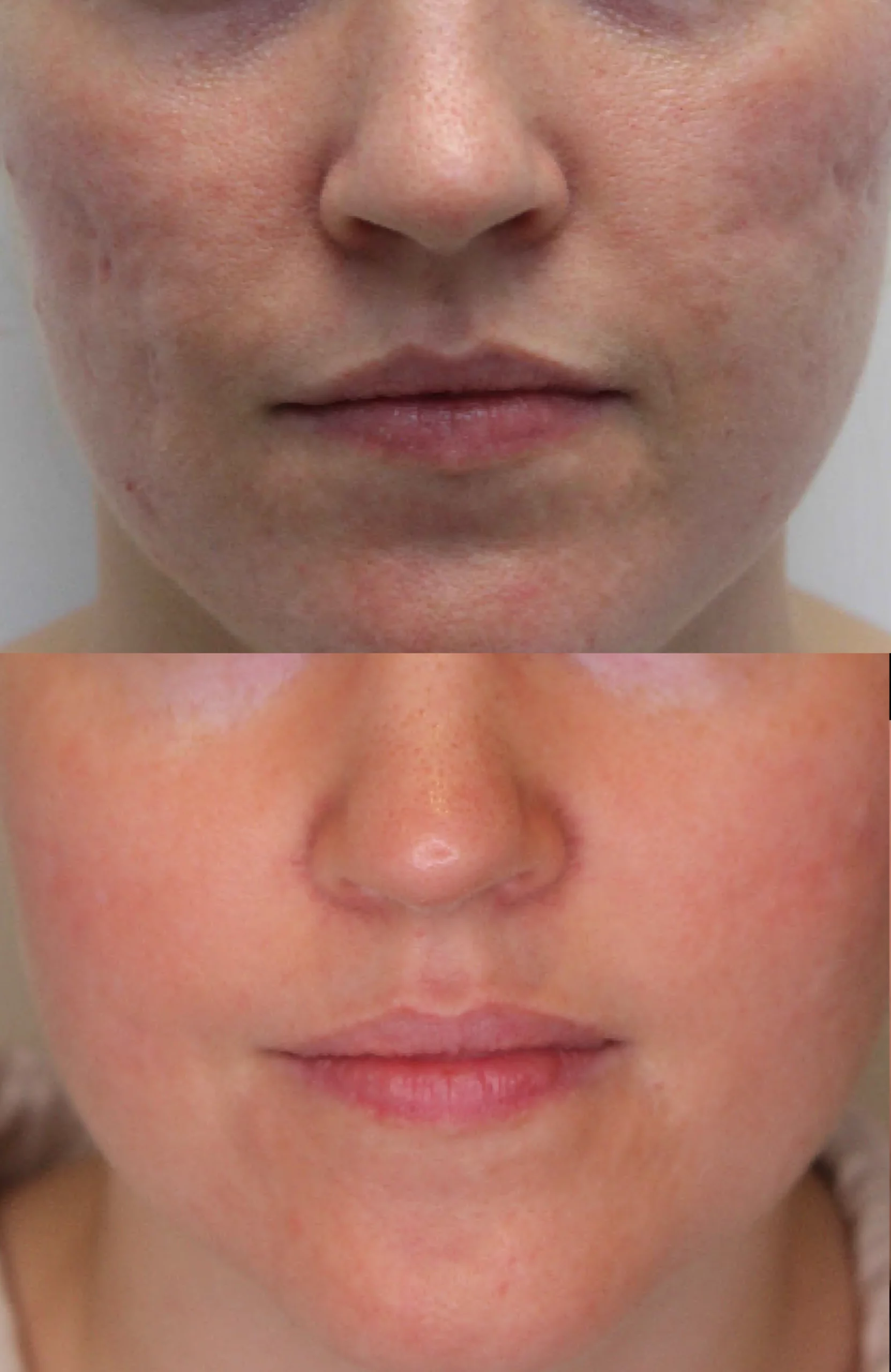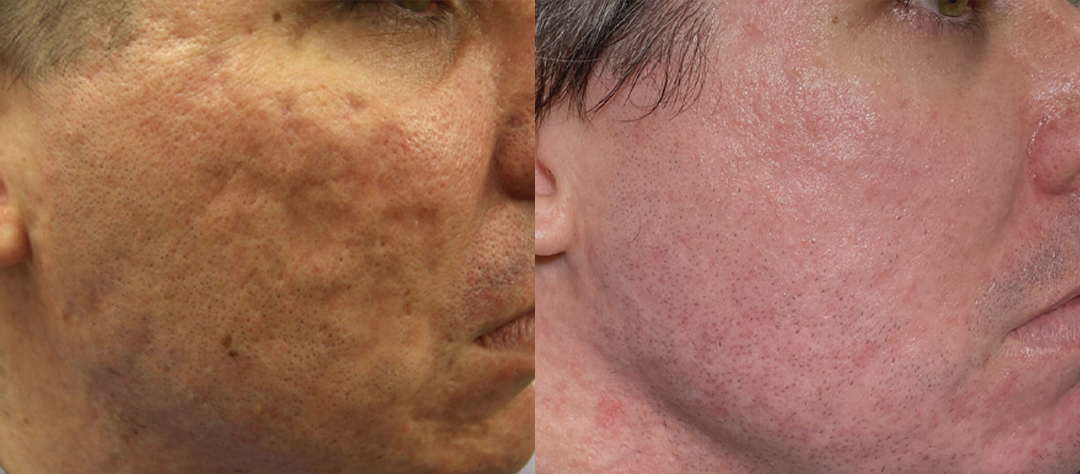Subcision is the definitive treatment for deep rolling acne scars. This procedure is akin to keyhole facial surgery & is designed to free up deep scar tissue caused by inflammatory acne. This treatment is frequently combined with lasers, deep peels & RF microneedling.
Key Points
- Subcision is a minimally invasive procedure
- Deep rolling & atrophic acne scars do best with this procedure
- This surgical procedure is performed by dermatologists & plastic surgeons
- There is minimal discomfort
- A real time assessment will give you an idea if your scar pattern is amenable to subcision
Subcision for acne scars at a glance
Our results speak for themselves

Before
After

Laser, RF, Subcision. Dermal filler used at the end for atrophic scars.
Ask us more about this treatmant
Preferred Consultation

Before
After

CO2 Laser, RF, Subcision. No filler in this case. Self-correction of atrophy extraordinary & not the norm.
Ask us more about this treatmant
Preferred Consultation

Before
After

Laser, Subcision, Filler, Pico laser for atrophic acne scars in darker skin type.
Ask us more about this treatmant
Preferred Consultation
FAQs
What is subcision?
Subcision or subcutaneous incision is a procedure that was published by a dermatologist in 1995. This treatment or technique uses instruments to free up scar tissue under (not on) the skin.
The majority of deep, rolling acne scars will have fibrous bands that pull down on the skin’s surface causing waves, ripples & divots. Subcision frees up the bands, causing the scar to raise up, in turn normalizing the contours of the skin.
How is this procedure performed?
Before undertaking this procedure your dermatologist will map your scars in real time. This will give us an idea as to what type of scars will respond.
Subcision is performed in an operating room under local anaesthetic. In more extensive cases we use conscious sedation.
What variations of subcision are there?
Results depend on the skill set you’re your surgeon. Variations include-
- Point subcision using ‘sharp’ instrumentation
- Field subcision using both sharp and blunt devices
- Energy based subcision
- Minimal subcision with soft tissue filler augmentation
The procedure takes between 5 to 40 minutes to perform, depending on the extent of acne scarring.
What types of scars respond best to surgical subcision?
Rolling scars do best with this procedure. These scars are wavy divots that can be seen in normal lighting. Rolling scars have very little surface change, as fibrous bands lie under the skin’s surface.
Deep ice pick scars & boxcar acne scars can improve with subcision as the bands extend into the subcutaneous layer.
Can this procedure be performed on all skin colours?
All skin types & ethnicities can be treated with this procedure as work under the surface of your skin. In most cases we employ other techniques to revise your scars, including lasers, RF microneedling, peels, surgery & dermal fillers. Devices & techniques are dependent on your skin tone.
Is it painful?
No. Most patients are given conscious sedation for this procedure. This is on top of nerve blocks, local anaesthesia and numbing cream. We take this procedure seriously, and hence will ensure your comfort levels during and post treatment.
Post subcision there may be a dull ache, with swelling that takes 3-7 days to settle.
What is the downtime following subcision?
Our dermatologists will give you an accurate indication of downtime. This ranges from 1-2 days with limited point subcision, through to 8 days with multi-level field subcision. As this treatment is conducted via a keyhole incision, the overlying skin is not injured.
In most cases, the limiting downtime is due to secondary procedures such as TCA and laser resurfacing.
What are the expected results?
Results depend on the subcision technique & instrumentation as well as the amount of scar tissue vs atrophy (loss of collagen).
In most cases a good (>50%) improvement can be seen at day 3 to 7. This improves over time. Most cases of scar revision will require between 2-4 sessions.
Why is there a variation in outcomes following this procedure?
Outcomes depend on who is performing the procedure.
Plastic surgeons & dermatologists are taught how to perform surgical procedures safely, effectively, & efficiently during our specialist training program.
Results depends on-
- The specialist. Technique dependent as with all surgical procedures.
- The instrument. Sharp vs blunt devices. There are over a dozen to choose from.
- The immune response of the patient.
- The amount of background inflammation (active acne).
Products

O Cosmedics SPF range
$54.00-$64.00

O Cosmedics retinol range
$102.00-$139.00
Subcision is minimally invasive key-hole surgery for acne scars .This method of scar revision is highly effective for deeper rolling acne scars. The procedure is painless as it is conducted under sedation in our operating theaters at Cutis Dermatology Brisbane.
Can subcision be combined with other treatments?
Subcision is best for deep rolling and tethered scarring. If you exhibit superficial scars such as boxcar, ice-pick, linear, saucer & undifferentiated polymorphic scars, your dermatologist may combine lasers, as well as surgical excision and peels.
In some cases, we inject soft tissue fillers, or autologous fat and stromal cells during the procedure itself. This is reserved for large volume atrophic acne scars.
What are the risks associated with subcision?
This surgical procedure is deemed minimally invasive, with a low risk. The side effects are proportional to the aggression of the procedure & the type of instrumentations used. It also depends on the anatomical site and depth of your scars.
Risks of subcision include bleeding, clots, haematomas, infection, nerve damage, damage to retaining ligaments, and post procedure bruising. Some of these side effects may apply to your procedure. Your treating surgeon will discuss the specifics, pertaining to your scar pattern.
What are other ways to treat rolling acne scars, apart from surgery?
There are other less invasive procedures (less efficient) to treat rolling & mixed acne scars. These include RF microneedling using our Genius or Infini RF systems. Deep lasers can also be used to treat rolling scars using one of our many erbium & CO2 devices.
Non-surgical procedures can be performed by your dermatologist or the practice nurse. Discuss options with your treating physician.
How does subcision compare to lasers, microneedling or RF microneedling?
In the context of deep rolling acne scars the primary treatment of choice is surgical subcision. This gives far better outcomes than machines, including state of the art lasers.
Lasers & microneedling can improve most types of scars, but they are not specific. Patients are free to choose their treatment of choice as-
- Non-surgical options provide a cost saving
- Laser, microneedling & RF microneedling is less invasive & intimidating than surgery
If you would like a cost effective, simple solution to scar revision, book a consultation with our procedural nurses at Cutis. They can provide you with a total treatment plan.
What is energy based subcision?
This is a novel way to subcise. We do have specific devices for this job, namely RF insulated cannula subcision. There is no advantage of using energy devices over manual subcutaneous subcision.
1470 fibre diode lasers have recently entered the market, trials are underway in 2022-23
Why should acne be in total remission when you are undertaking scar revision?
Ever tried to build muscle if you have an injury? It won’t happen. Hence your body is not going to efficiently build & remodel collagen if you have inflammatory acne.
Your dermatologist will assess your condition and provide you with effective solutions for both your acne & acne scars.
What is the cost of surgery for acne scars?
As of the time of writing 2022, Medicare is changing the schedule to help recoup the 120-billion-dollar deficit from Covid. They are proposing to revise item numbers including the benefits for subcision & other procedures.
Your dermatologist will give you an indication of these changes. As it stands, surgical procedures for scar revision on the face that is objectively severe & if performed by a specialist dermatologist, plastic or ENT surgeon carries a rebate. This rebate does not apply to cosmetic GPs/doctors.
What should you consider before undertaking scar revision?
Undergoing facial scar revision is a big choice for patients. Here are some helpful points that may help you along your journey.
- Always control your acne. You will go infinitely faster & better with any revision process. This means absolute (or almost absolute control), it does not mean ‘much better than before.’ If in doubt, see a dermatologist.
- Match a procedure to your scar pattern. It’s not a dinner menu, don’t pick and choose. Be guided by your dermatologist or plastic surgeon.
- Multiple sessions. Very occasionally we can treat scarring in one session. In most cases it requires multiple, between 2-4 + sessions.
- Costs. As a guide, scar revision is about the same price as getting braces. If costing is an issue, the procedural nurses at Cutis can help. They will come up with a cost effective & effective treatment plan for your scar pattern.
Downtime. If any treatment is going to work, there is an associated recovery period. Your specialist will discuss this with you.
Dr Davin Lim on the future of surgical subcision
Subcision is the procedure of choice for deep rolling acne scars. We use over a dozen instruments including Nokor’s, cataract blades, blunt dissectors, Liberators, Toledo’s, dovetails, hypodermic, and energy-based cannula. The instrument depends on the job.
In the next decade, we will see more technology being developed to image scars, namely high-resolution USS or ultrasound. We are not quite there yet as high resolution only goes down a few (if that) millimeters. USS not only guides the physician as to the area but can image deeper structures, namely neurovascular bundles & other important structures like retaining ligaments. Will this help an experienced specialist? Probably not, however, it would be a great training tool for less experienced surgeons.
Newer energy based subcision devices have entered the market in 2021-22. We have used RF insulated cannula since 2016. Gen one devices offer no advantage in the context of outcomes. With diode fiber laser assistance, it may provide thermal heating under the skin. This may remodel collagen faster, to the detriment of overheating & fat atrophy. Possibly the use of USS guidance with impedance monitoring (or heat monitor with cut-offs) is the device of the future. Give it 10 years.


